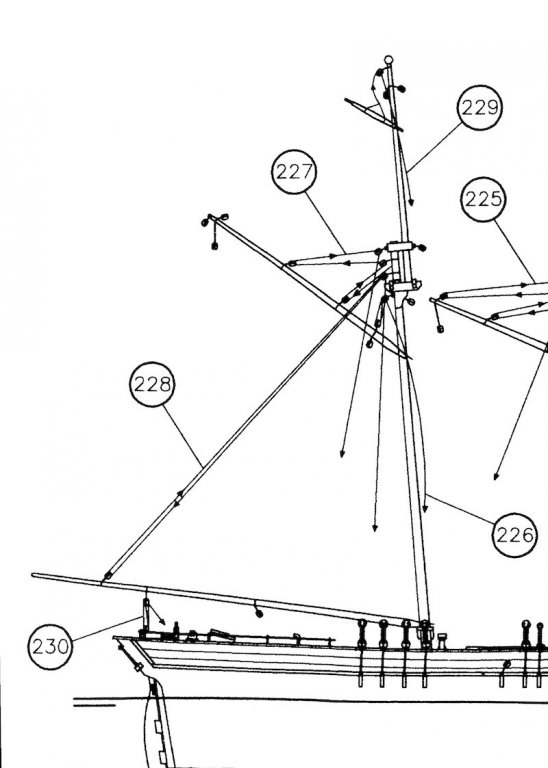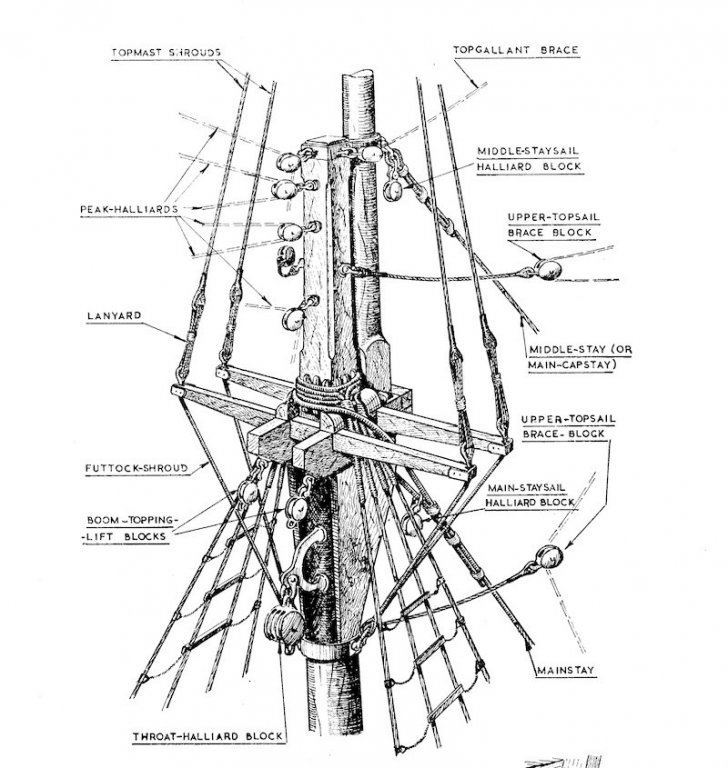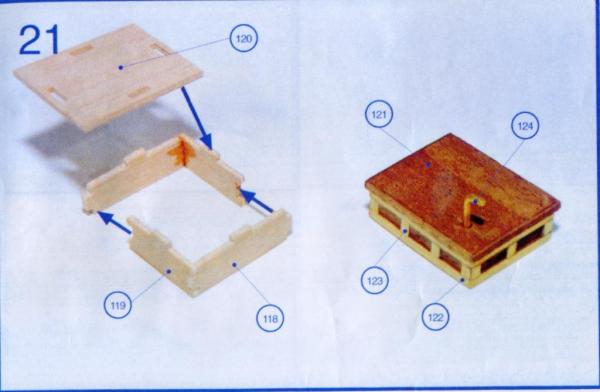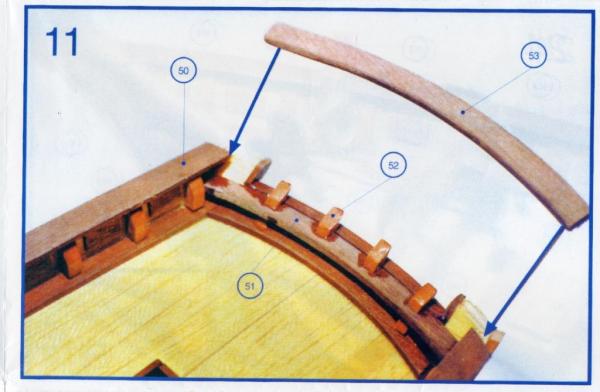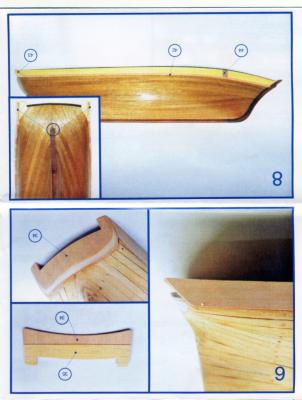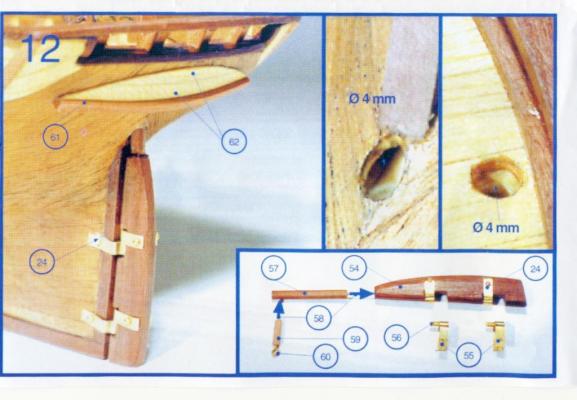
gthursby
Members-
Posts
43 -
Joined
-
Last visited
Content Type
Profiles
Forums
Gallery
Events
Everything posted by gthursby
-
Scootish Maid rigging problems - gaff and boom
gthursby posted a topic in Masting, rigging and sails
As I wrote in a post a few days ago I am starting to rig a model of the Scottish Maid using an Artesania kit. I find the rigging instructions confusing to say the least (this is likely to be the first of many!) In the Artesania diagram the rigging for the gaff and boom is very confused. Firstly, I would have thought that the halliards should be attached further along the gaff to give a sensible amount of leverage. Secondly, there doesn't seem to be enough blocks to rig both the gaff and the boom. A diagram that I found in Underhills book shows the boom lift as 2 blocks attached to the tree trestles as shown. Does this seem a sensible arrangement for the Scottish maid? I'm also unclear as to where on the deck these ropes would be anchored. In the kit instructions, after describing planking the hull they say that all the hard work has been done and all you have to do is rig the model as per the diagrams - Ha! -
I'm building a model of the Scottish Maid and am in the early stages of rigging her. I'm using the kit guides and also the Underhill book volume 2. The Underhill guide is far more detailed, but uses so many technical terms that I find it very hard to follow. Basically what I would like is a way of understanding which part of the rigging does what as that would help me to get it right (albeit in probably a simplified form). In some cases it is fairly obvious, but the function of some lines I find obscure. I realise that the answer to my question will depend on the type of rig and the era in which the vessel was built.
-
I'm building the Artemesia Scottish Maid but am trying to improve the accuracy of certain parts of the construction. Looking at the above posts it seems as though on some occasions the chain plate is a bar whilst on others it is a chain. Any guidelines as to which would be appropriate to the Scottish Maid would be greatly appreciated!
-
Skylight
gthursby replied to gthursby's topic in Discussion for a Ship's Deck Furniture, Guns, boats and other Fittings
Thanks, Davyboy. I read up on Scottish Maid in MacGregor's "Fast Sailing Ships" book and it appears that most of Hall's plans were destroyed by fire in WWII. Consequently only half models exist and everything else, including the deckhouses, is reconstructed from contemporary paintings etc of her and other similar Hall vessels. Reading the book it seems that a Hall characteristic was to fit the bowsprit with its heel tenoned into the pawl post; however this is not how it appears in Artesinia's plans so that is another modification I will have to make. Fortunately I haven't fitted it yet. I've already built the stern in a different way to them and used walnut planking instead of the supplied mahogany in a hopefully more realistic planking layout, so at the present rate there won't be much of the original kit left! -
Skylight
gthursby replied to gthursby's topic in Discussion for a Ship's Deck Furniture, Guns, boats and other Fittings
Thanks davyboy, I did consider that option, but thought that having glazing at deck level would be impractical. Most of the skylights I've seen have had glazing on sloping surfaces on top of a deckhouse. Is it common to have glazing on the side? btw I treat some of Artesenia's plans with some scepticism, hence questions such as this one. -
I'm building the Artesania Scottish Maid kit and am puzzled by this deckhouse which they refer to as a skylight. I don't see how it can be a skylight even if the sides were shuttered - it doesn't look like anything else I've seen that is called a skylight. This gives me 2 questions - if it's not a skylight what is it? it's probably only about 3ft tall and has no obvious point of access. Wouldn't a ship of this type need a skylight since all the accommodation is below deck.?
-
Working with lime planks that are 1.5mm thick an maximum approx 5mm wide, I find it very hard to accurately mark out the shape and then cut then (this is the first layer). They are far too small to saw and I find that a craft knive tends to go offline and follow the grain, no matter how careful I am. Any hints? Thanks
-
I'm in the middle of doing the first layer of the Artesania "Scottish Maid", which is my first build I don't know about the longboat that you are building, but the Scottish Maid kit instructions give a "simplified" (all things are relative!) planking scheme that gives the hull the right shape but does not give an authentic representation of the run of planking on an actual ship. This is discussed here - http://modelshipworld.com/index.php?/topic/4934-modifying-a-kit-planking-scheme/ if you look at the planking tutorials referred to at the top of this forum, they are designed to give the more authentic layout, so if you wonder why they seem very different form the kit instructions, that is why. The Scottish Maid has very fine lines, so I am able to check the fitting of the planks by tempoarily sticking them on with dressmakers pins. The holes made with the pins can also be used as pilot holes for the planking pins used in the kit. I often pin on several planks at a time and try to check that nothing is going drastically wrong. Sometimes the model looks more like a hedgehog than a ship! In my very limited experience it is worth temporarily fixing parts by pinning or clamping first to check that all is well before glueing. Maybe with more experience this is not necessary. Best of luck!
-
Thanks for all the replies. I hadn't realised that the kit was based on Macgregor plans. I found a picture of the half model of "Scottish Maid" in Aberdeen Museum, but this only appears to go up to deck level and doesn't include the bulwarks. It's a shame that thepics of the John Heard model don't show the stern very well. Are there any drawings of the stern in the Macgregor book?
-
I've started building the Artesenia "Scottish Maid" kit and am having trouble interpreting the stern structure. I've looked at pictures showing Google images search and there is a very wide difference in the way different modellers have interpreted this. I've attached photos from the instructions that gives the Artesenia version. To my inexpert eye this looks odd. The transon bulwark has an open part to it, which seems strange and the "decorative enhancements" look strange also. The main hull planking curves fairly sharply upwards towards a rail at the bottom of the bulwark opening. Some of the pictures I've found on the internet such as http://www.modelships.de/Scottish-Maid_II/dIMG_7955.jpg show what to me looks like a more conventional stern. Which is likely to be correct? Are there well authenticated plans of the "Scottish Maid" in existence or are the kit manufacturers working from outline details and making a guess at the rest? I'm trying to work out what to do before starting my first layer of planking.
-
I've started work on the Artesania Latina "Scottish Maid" and have nearly got the frames etc ready for planking. Looking through the tutorials on this site I find very different planking methods from that given by AL. You can see the results of their instructions in several kit build logs on this site or clearly in this pic http://www.shipsofscale.com/phpBB3/download/file.php?id=2581&sid=01a8caf0a5f9c49923eb132fe3fc17c7 Two questions - Is the planking structure this gives authentic, or as I suspect, a compromise made by the manufacturer to make construction easier and allow the use of the straight 5mm strips provided? If so, is it feasible for me to plank the first layer using the simplified method and then try for something more authentic using 2nd layer veneers? The 2nd layers in the kit are 5 x 0.6mm. I presume that if I change the method I'll need to buy different material. The ship is a 1:50 with a hull length of around 70ft- she has fine lines which should help planking, I'd guess. Any suggestions as to what material I would need to buy? Thanks for any help
-
My point (or one of them) was that the planking scheme given by the AL instructions does not give the same result as that described in David Antscherl's "A primer on planking" given in the tutorials section of the Building Framing and Planking forum. Antscherl's method is more demanding as it requires far more shaping of the planks, but presumably gives a more accurate representation of the way it would be done in an actual vessel. I could be wrong, but that's what I deduce from that and other tutorials in the same section. Al's method is certainly a simpler method of veneering the hull, but probably compromises realism.
- 19 replies
-
- scottish maid
- artesania latina
-
(and 1 more)
Tagged with:
-
This is also my first build. If I understand correctly the outer planking strips were missing from your kit. My problem, which I only discovered after opening the kit at Christmas is that the first layer strips are missing; I'm goiing to contact the supplier. the number of outer planks looks rather meagre - enough to do the job but with vey little to spare in case of errors. Are these common problems with Artesania? For the price it certainly should not be. The planking intructions would not produce a planking layout close to that of a real ship - I don't think they would ever have odd bits in the middle to fit in gaps. Maybe you need more advance single planked hull kits to get this (?)
- 19 replies
-
- scottish maid
- artesania latina
-
(and 1 more)
Tagged with:
-
Hi, I've done some modelling in the (distant) past, but this will be my first attempt at a plank on frame construction. I'll be working on the Artesania "Scottish Maid". A starting question - what do you think is the best method of glueing the bulkheads to the frame whilst keeping them exactly at 90 to the keel and at the right height with respect to the deck? Clearly this is critical, since if is inaccurate it will cause endless problems. Do you use jigging, and if so what type? I'm guessing that there will be various alternatives. thanks Graham
About us
Modelshipworld - Advancing Ship Modeling through Research
SSL Secured
Your security is important for us so this Website is SSL-Secured
NRG Mailing Address
Nautical Research Guild
237 South Lincoln Street
Westmont IL, 60559-1917
Model Ship World ® and the MSW logo are Registered Trademarks, and belong to the Nautical Research Guild (United States Patent and Trademark Office: No. 6,929,264 & No. 6,929,274, registered Dec. 20, 2022)
Helpful Links
About the NRG
If you enjoy building ship models that are historically accurate as well as beautiful, then The Nautical Research Guild (NRG) is just right for you.
The Guild is a non-profit educational organization whose mission is to “Advance Ship Modeling Through Research”. We provide support to our members in their efforts to raise the quality of their model ships.
The Nautical Research Guild has published our world-renowned quarterly magazine, The Nautical Research Journal, since 1955. The pages of the Journal are full of articles by accomplished ship modelers who show you how they create those exquisite details on their models, and by maritime historians who show you the correct details to build. The Journal is available in both print and digital editions. Go to the NRG web site (www.thenrg.org) to download a complimentary digital copy of the Journal. The NRG also publishes plan sets, books and compilations of back issues of the Journal and the former Ships in Scale and Model Ship Builder magazines.

